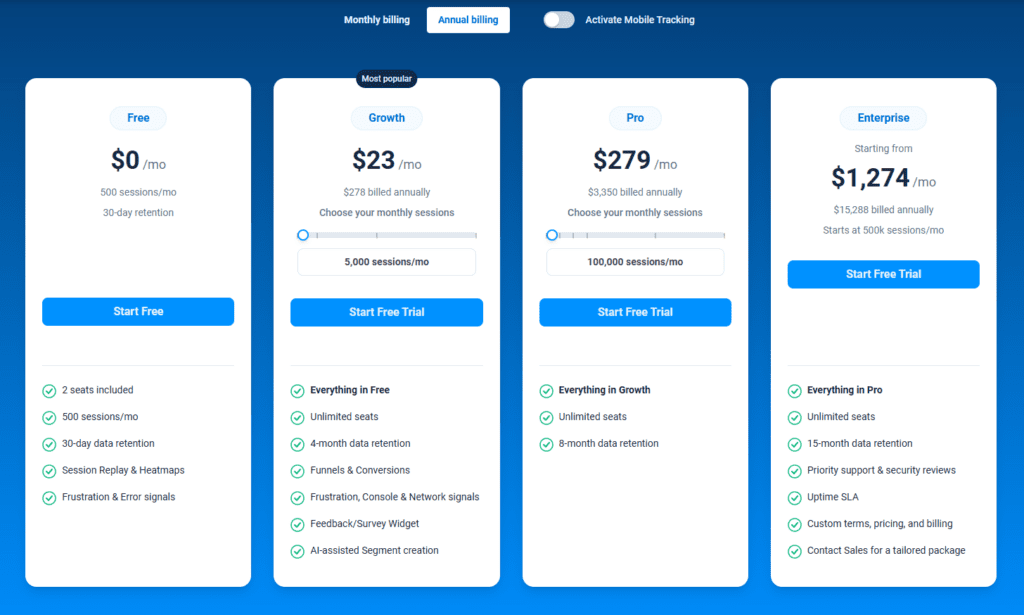FullSession vs. Hotjar Heatmaps: Which Wins for SaaS? ...

The Definitive Guide to User Persona Research
Demographic and psychographic data come together to create the user persona: a snapshot of a subgroup of your existing user base.
Products that resonate deeply with users start with understanding their thought processes. By mapping the common ground between your audience, you'll forge an unshakeable connection that sparks loyal customers.
Imagine creating products and services that instinctively understand your audience's motivations and behaviors—that's exactly what your design team can do with these insights.
Chances are, you've got a vague definition of a user persona. But to craft one that genuinely pays off, we need to dig past the obvious and get into the nitty-gritty.
In this guide, we'll delve into the what, why, and how of creating personas that speak to your business objectives to help you create a more targeted, effective marketing strategy.
A Review of the User Persona
User personas are like detailed snapshots of the folks you're designing for. Picture this: each persona is a one-page bio that includes not just a name and photo but also personal details and clear goals.
These aren't just made-up characters; they’re built from real observations of actual or potential users to give you a true-to-life glimpse of your audience.
With user personas, you gain a boots-on-the-ground understanding of your users' daily struggles and desires, and that intel empowers your team to craft products and marketing messages that truly resonate. What users want and need isn't a mystery anymore.
This approach gets to the heart of it by using concrete data to inform decisions, leaving room for collaboration and moving forward as a united front.
User Personas vs. Market Segments
User personas and market segments are both useful for understanding who you're dealing with, but they do it in different ways.
Market segments sort people into big groups based on things like age, where they live, or how much they earn. User personas take it a step further by bringing those numbers to life. They bring those statistics to life and create a detailed profile of an individual who represents a segment of your audience.
User Personas vs. Buyer Personas
Another distinction we have to make is user personas vs. buyer personas. User personas dive into the world of the people who actually use your product. Picture being able to read the minds of your users.
What would they tell you? They'd reveal their needs, behaviors, and pet peeves with your product. That's what you get when you focus on understanding them.
On the flip side, the buyer persona is all about figuring out who’s going to buy your product. These personas get into the nitty-gritty of the buyer's role in the purchasing process, what makes them decide to buy, and how they like to shop.
Elements of a User Persona
Building a user persona is like sketching out a detailed character for a story. Here are the essential bits that bring this character to life:
- Demographics: Start with the basics—age, gender, job, education level, and how much they make. These are the building blocks that help you get a clear picture of who your persona is.
- Psychographics: This is where you dive into what makes your persona tick. What are their values, interests, and lifestyle choices? It's all about getting into their head to see what drives their decisions.
- Goals and motivations: Figure out what your persona is aiming to achieve with your product. Understanding their goals and what motivates them to achieve them can help you align your product just right.
- Challenges and pain points: Pinpoint the obstacles standing between your persona and their objectives. Armed with this insight, you can identify how your product can meet their specific needs.
- Behavior patterns: Look at how they typically behave with similar products or services. What are their habits, and how do they like to engage with technology or brands?
- Preferred communication channels: Where does your persona usually hang out for information? Whether it's emails, social media, or face-to-face chats, knowing this helps you figure out where to direct your marketing efforts.
- Brand interactions: Think about their past experiences with your brand or others in the market. What worked for them, and what didn’t?
- Decision-making process: Understand how your persona makes choices. Are they quick to decide, or do they mull overloads of information first?
What is User Persona Research?
Now that all that is out of the way, let's talk about user persona research⎯the first step to creating marketing personas.
Persona research focuses on turning data into realistic, relatable characters that your team can really understand and work with. This kind of research usually involves collecting insights through surveys and interviews and analyzing data to sketch out the key traits of your different user types.

Types of User Personas
When you're setting up user personas for your project, it’s good to know there are a few different types you might want to consider: primary, secondary and served personas. Product development and marketing success depend on carefully considering each component.
Primary Persona
Your primary persona is your main focus. This is the typical user of your product—the one you’re really aiming to please. Most of your design and development decisions will revolve around meeting this user's needs and expectations.
Secondary Persona
Then you have your secondary personas. These people are still important but don't represent most of your users. They have specific needs that are a bit different from your primary users but still important enough to be considered in your planning.
Think about it: by considering these secondary personas, you're casting a wider net and ensnaring a broader audience with your product.
Served Persona
Lastly, there are served personas. These users might not directly interact with your product but they benefit from its use.
For example, if you’re creating an app for kids to learn math, the kids are your primary personas, but parents and teachers might be your served personas. They're the ones who might decide to buy the app and support its use, even though they’re not the ones using it day-to-day.
6 Steps to Creating Personas for Your Business
Building user personas isn't just helpful; it's important for nailing your product development and marketing. Here’s how you can roll out personas that really reflect who your users are and what they need.
1. Create Your User Research Plan
Starting off on the right foot with user persona creation means nailing down a solid user research plan. This is your blueprint for gathering the insights you'll need to build accurate and useful personas. Here's how to get cracking:
Define your objectives: What do you need to know about your users? Are you trying to understand their buying behavior, usage patterns, or pain points? Setting clear goals helps you focus your research efforts effectively.
Choose your methods: Decide on the research methods that will best help you achieve your objectives. Will you conduct surveys to reach a wide audience or do in-depth interviews for more nuanced insights? Maybe you'll use a mix of both, along with observational studies or usability tests.
Plan your resources: Consider what resources you'll need, such as a budget, tools, and team members. Who will design the surveys? Who will conduct the interviews? Make sure you have all the pieces in place.
Set a timeline: Research doesn't happen overnight. Draft a realistic timeline for each phase of your research, from preparing questionnaires to analyzing data. This helps keep your project on track and ensures you're making progress toward developing those personas.
Identify your sample: Who will you be studying? Define the criteria for participants in your research. Make sure they represent a diverse cross-section of your target audience to make your personas as comprehensive as possible.
2. Collect Quantitative Data
When it comes to crafting user personas, you’ll want some solid numbers to back up your insights. Here's how you can collect that all-important quantitative data:
Survey Data
Surveys are your go-to for scooping up a bunch of info fast from a lot of people. You'll want to ask questions that cover the basics like age, job, and where they live, plus get into their habits and what they think of your product.
Keep your survey questions straightforward to avoid any mix-ups and to make sure you’re getting clear, usable answers. Tools like SurveyMonkey or Google Forms can help you whip up a survey in no time and analyze the results easily.
Behavioral Data Analytics
Behavioral analytics helps you understand how users actually interact with your product. You can use tools like FullSession to see what parts of your website or app users visit the most, where they spend their time, and what they click on. Doing so helps you figure out what features catch their attention and where they might be hitting snags.
3. Collect Qualitative Data
Once you've got your numbers lined up from quantitative research, it's time to add some color to those black-and-white stats with qualitative data. This kind of data helps you understand the full story behind your users, which gives the depth and realism of your persona. Here's how to go about it:
User Interviews
Grab some time with your users for one-on-one chats. You can do these interviews in person, over the phone, or through video calls.
Want to know what motivates your users, what frustrates them, and what they expect from your product? This method has got you covered.
Focus Groups
Put together a small group of users and get the conversation flowing. Bring people together in a focus group and watch the conversations spark. New ideas and insights start flowing, and it's amazing what can emerge.
Just remember to keep things on track and make sure everyone gets a chance to speak up.
Observational Studies
Sometimes the best way to learn isn’t by asking but by observing. Watch how people use your product in their own environment. This can help you spot where they struggle or what they really enjoy without the filter of a questionnaire or interview setting.
4. Segment Your Data
Once you've completed qualitative and quantitative research, the next step is to organize it into clear groups. When analyzing user behavior, look for the common ground that ties it together—it's about recognizing those threads that weave a fabric of understanding.
You'll likely stumble upon users who share common ground, whether they tackle the same pain points, hail from similar industries, or are simply drawn to your product for the same motives.
From there, you can start grouping these insights into meaningful user segments. These could be anything from user demographics to how often they use your product. Grouping users by their priorities gives you a bird's eye view of what drives them.
5. Create User Personas
Once you've sorted your data into different segments, it's time to bring those abstract numbers to life by creating user personas. These are essentially detailed characters that represent the various types of users you're targeting. Here's how to go about crafting them:
Pull together key traits: Start by collecting the essential details from each data segment—things like age, job, lifestyle, needs, and preferences. This mix of demographics and behaviors will help flesh out each persona to make them more than just a statistic.
Weave a story: Give each persona a backstory that connects all their traits into a single, coherent story. What’s a typical day for them? What challenges do they face? How do they make decisions? This story should make each persona feel real and relatable.
Give them a name and a face: Assign each persona a name, a face, and even a few personal quirks or hobbies. Make your users three-dimensional, and suddenly, your team's design thinking shifts; you'll see a significant uptick in innovation driven by a genuine desire to make a positive impact on people's lives.
Outline their goals and challenges: Clearly lay out what each persona is trying to achieve and the obstacles they encounter. This helps your team understand how to tailor your product or service to meet these specific needs.
Get feedback and refine: Once you’ve drafted your personas, share them around with your team for input. Refining your personas leads to shockingly accurate profiles that literally put you in your customers' shoes, so you can empathize with their needs.
6. Share Your Personas
After you've created your user personas, it's time to get them in front of your whole team. Put together straightforward documents or slides with each persona's main details and store them where everyone can easily find them, like on a shared drive or an internal wiki.
Call a team meeting to explore these freshly minted personas. Share the story behind their creation and showcase how they inform different aspects of your projects. To really connect with your target audience, invite your personas to the table, so to speak. Encourage your team to keep these personas in mind as they tackle their daily tasks, whether in design, marketing, or product development.
Keep the door open for feedback, too—personas should evolve based on new insights and user data. Regularly check in on how these personas are being used and measure their impact on your projects to make sure they’re truly helping to steer your strategies in a user-focused direction. This way, everyone stays on the same page, and your efforts will remain centered around the user.

What Are the Benefits of Creating User Personas?
The first step in product development is to create personas to guide your decisions throughout the process. Here’s a breakdown of the key benefits:
Get to Know Your Users
Imagine being able to step into the shoes of your ideal customer, understanding their thoughts, feelings, and needs as if you were them—that's essentially what user personas allow you to do. Ask yourself: What gets your users excited? What keeps them up at night?
Keep Everyone on the Same Page
Having detailed personas means your whole team, from designers to marketers, can keep a laser focus on who they’re serving. By taking this approach, you can rest assured that every piece of work—be it a new feature or a marketing push—is carefully crafted to meet the exact needs and desires of your users.
Design That Delivers
When you design with specific personas in mind, you’re more likely to create features that users will love. This means less guesswork and fewer missteps, which leads to better user satisfaction and less frustration with your product.
Marketing That Resonates
Knowing exactly who you’re talking to makes all the difference in marketing. With personas, your messages can be tailored to speak directly to different segments of your audience, making your campaigns more engaging and effective.
Smoother Team Communication
User personas provide a common reference point for everyone in your organization, making discussing and deciding product strategies easier. When we're all speaking the same language, communication flows freely, and projects progress with ease.
User Persona Template
It can be tricky to create a user persona from scratch without prior experience, so we've created a template you can use to start:
- Persona Name: [Give your persona a fictional name that reflects their character]
- Photo: [Attach a representative image or avatar]
- Demographic Information:
- Age:
- Gender:
- Location:
- Occupation:
- Education Level:
- Income Range:
- Psychographics:
- Personality Traits:
- Values:
- Interests/Hobbies:
- Lifestyle (e.g., urban, active, sedentary):
- Tech Savviness:
- Devices Used (e.g., smartphone, tablet, laptop):
- Preferred Platforms (e.g., iOS, Android, Windows):
- Goals and Motivations:
- Primary Goal [What is the main thing they want to achieve with your product/service?]:
- Secondary Goals [Other objectives they may have]:
- Challenges and Pain Points:
- Major Challenges [What major obstacles do they face in achieving their goals?]:
- Minor Challenges [Smaller issues that might frustrate them]:
- Brand Interactions:
- Previous interactions with your brand/product:
- Favorite features or aspects of your product:
- Pain points with your product:
- Preferred Communication Channels:
- How they prefer to receive information (e.g., email, social media, text):
- Best times to reach them:
- Buying Decision Factors:
- What factors influence their purchasing decisions (e.g., price, features, brand reputation):
- Quotes:
- Include one or two direct quotes that represent their views or feelings about your product or similar products.
- Additional Notes:
- Any other relevant information that helps round out the persona.
User Persona Examples
Want to understand persona development better? Let's take a look at these qualitative personas:
User Persona Example 1: Tech Startup App User

Persona Name: Tech-savvy Tom
Demographic Information:
- Age: 29
- Gender: Male
- Location: San Francisco, CA
- Occupation: Software Engineer
- Education Level: Master's Degree
- Income Range: $120,000 - $140,000
Psychographics:
- Personality Traits: Analytical, curious
- Values: Efficiency, innovation
- Interests/Hobbies: Coding, gaming, tech meetups
- Lifestyle: Urban, tech-oriented
Tech Savviness:
- Devices Used: Smartphone, laptop, smartwatch
- Preferred Platforms: iOS, Linux
Goals and Motivations:
- Primary Goal: Stay productive and connected with the latest tech tools.
- Secondary Goals: Find tech solutions that streamline daily tasks.
Challenges and Pain Points:
- Major Challenges: Needs tools that can integrate seamlessly with a variety of platforms and services.
- Minor Challenges: Finds many solutions overly complex or not user-friendly.
Brand Interactions:
- Previous interactions: Regular user of productivity apps
- Favorite features: Seamless integration, user-friendly interface
- Pain points: Dislikes frequent updates that disrupt usability
Preferred Communication Channels:
- Receives information via email, tech blogs
- Best times to reach: Evening
Buying Decision Factors:
- Look for functionality, integration capabilities, and developer community support.
Quotes:
- "I need tools that work as hard as I do and are as smart as the tech I create."
Additional Notes:
- Highly valued customer service and technical support.
Tech-savvy Tom is all about using the latest gadgets and software to stay ahead. He's a young software engineer who needs tools that mesh well with his busy, tech-filled life. Companies can catch Tom's eye by developing cutting-edge products that highlight seamless integration and usability.
Marketing strategies should focus on showing off these high-tech features through platforms like tech blogs and LinkedIn, where Tom is likely hanging out. Also, having a support team that's quick to help with tech issues would definitely keep him happy and loyal.
User Persona Example 2: Health and Wellness App User

Persona Name: Active Annie
Demographic Information:
- Age: 42
- Gender: Female
- Location: Austin, TX
- Occupation: Freelance Nutritionist
- Education Level: Bachelor's Degree
- Income Range: $65,000 - $80,000
Psychographics:
- Personality Traits: Energetic, health-conscious
- Values: Wellness, self-care
- Interests/Hobbies: Yoga, cooking, blogging about health
- Lifestyle: Active, community-focused
Tech Savviness:
- Devices Used: Smartphone, tablet
- Preferred Platforms: Android
Goals and Motivations:
- Primary Goal: Maintain a healthy lifestyle and inspire others to do the same.
- Secondary Goals: Find new wellness techniques and share them with her audience.
Challenges and Pain Points:
- Major Challenges: Finding reliable, easy-to-understand health tracking tools.
- Minor Challenges: Overwhelmed by the amount of unverified health information online.
Brand Interactions:
- Previous interactions: Uses several fitness trackers
- Favorite features: Accurate tracking, motivational insights
- Pain points: Apps that offer poor user experience or inaccurate data
Preferred Communication Channels:
- Receives information via social media, wellness podcasts
- Best times to reach: Morning
Buying Decision Factors:
- Trustworthiness of the app, user reviews, and scientific backing.
Quotes:
- "I want an app that helps me stay on track and gives me real results without the fuss."
Additional Notes:
- Actively participates in online wellness communities.
Active Annie is a middle-aged nutritionist who’s really into her health and always scouting for apps that track her wellness accurately. She's not just about keeping fit; she wants tools that motivate and inform.
Businesses in the health and fitness industry should target Annie with apps that are backed by science and easy to use. They should use social media and wellness podcasts for promotions, emphasizing real user stories and expert approvals to build credibility.
Community events or wellness challenges could also engage her deeply and make her a fan of their products.
Collect Useful Persona Data With FullSession
Crafting user personas involves a lot of data collection and statistical analysis--tedious work that not every company has the time for. Luckily, FullSession has just what you need to create more accurate user personas:
- Behavioral recording: FullSession captures user sessions, showing you real-time interactions such as mouse movements, clicks, and scrolls. Step into the shoes of your website visitors and observe their actions firsthand. You'll uncover patterns, identify patterns, and isolate obstacles that are hindering their progress, giving you the power to refine their journey.
- Heatmaps: Heatmaps are great for visually showing where users are clicking, moving, and scrolling on your site. They help you identify hot spots of activity and areas that might be overlooked to give you a clearer idea of what catches users' attention and what doesn’t.
- Event tracking: With FullSession, you can track specific actions that users take, like filling out forms, downloading content, or viewing pages. This feature takes the guesswork out of understanding your users, connecting the dots between their actions and what they really want.
- Feedback tools: FullSession includes tools that let you collect direct feedback from your users. Whether through on-site surveys or feedback forms, this feature allows you to hear straight from the users about their experiences, expectations, and any challenges they encounter.
FullSession Pricing Plans

The FullSession platform offers a 14-day free trial. It provides two paid plans—Basic and Business. Here are more details on each plan.
Here are more details on each plan.
- The Free plan is available at $0/month and lets you track up to 500 sessions per month with 30 days of data retention, making it ideal for testing core features like session replay, heatmaps, and frustration signals.
- The Growth Plan starts from $23/month (billed annually, $276/year) for 5,000 sessions/month – with flexible tiers up to 50,000 sessions/month. Includes 4 months of data retention plus advanced features like funnels & conversion analysis, feedback widgets, and AI-assisted segment creation.
- The Pro Plan starts from $279/month (billed annually, $3,350/year) for 100,000 sessions/month – with flexible tiers up to 750,000 sessions/month. It includes everything in the Growth plan, plus unlimited seats and 8-month data retention for larger teams that need deeper historical insights.
- The Enterprise plan starts from $1,274/month when billed annually ($15,288/year) and is designed for large-scale needs with 500,000+ sessions per month, 15 months of data retention, priority support, uptime SLA, security reviews, and fully customized pricing and terms.
Install Your First Website Feedback Form Right Now
It takes less than 5 minutes to set up your first website or app feedback form with FullSession, and it's completely free!
FAQs About Researching User Personas
What’s the difference between user personas and buyer personas?
User personas focus on your product's actual target users, delving into their daily habits and needs.
Buyer personas, on the other hand, are all about the individuals making the purchase decisions, often including their job roles, industries, and decision-making power.
How often should I update my personas?
Keep your personas fresh and relevant by reviewing them at least once a year. As your market and user base evolve, updating your personas ensures your strategies remain on point and effective.
Can I have more than one primary persona?
Yup! Having multiple primary personas can be beneficial if you're targeting distinct user groups with different needs. Just make sure you manage your resources so each persona gets the attention it deserves to keep your strategies sharp.
What’s the difference between a user persona and a customer profile?
User personas and customer profiles serve similar purposes but are used differently. A user persona is a semi-fictional character that represents a key user type within your target audience, crafted from both data and a bit of creative storytelling to embody their needs, behaviors, and goals.
On the other hand, a customer profile is generally a more data-driven representation that includes specific information about segments of your customer base, focusing on demographics, buying patterns, and historical data without the narrative element of personas.